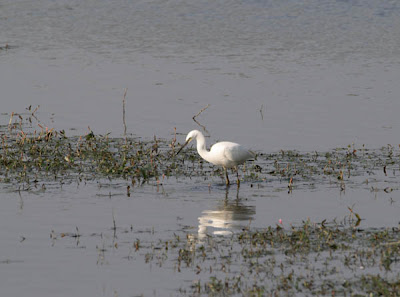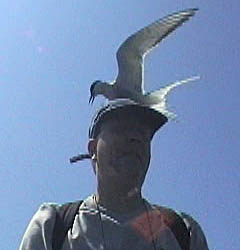I had my traditional frustrating time trying to get a picture of a tree sparrow. They weren't very accommodating, carefully choosing spots where the sun was behind them. This was the best effort, but the lack of any spark of light in the eye really detracts from the shot. I'm sure I'll get there with a bit of judicious photoshopping, but efforts so far have just made it look worse!

As last year a bullfinch was at the feeders, but mid moult the bird was more horror show than star - trust me, I've spared you the worst with this snap.

Moving on my lack of birding knowledge was shown up when I was trying to work out why this apparent woodpigeon wasn't - or rather where the white collar patches had gone. The answer was, I found out, that it was a juvenile. There you go, nothing special after all.
 Along the path to the waterside hides a migrant hawker dragonfly showed nicely for a short minute .............
Along the path to the waterside hides a migrant hawker dragonfly showed nicely for a short minute .............
common darters were at it everywhere .........................
 and a pathside rose was 'decorated' with rose galls.
and a pathside rose was 'decorated' with rose galls.
Down at the hides a female reed bunting did a bit of people watching .......
 and a greenshank ................
and a greenshank ................ and a few green sandpiper added some interest to the distant flocks of golden plover.
and a few green sandpiper added some interest to the distant flocks of golden plover.
A little egret stirred up the mud with it's right foot, poised to pounce - note to editor - doesn't show too well in such a small snap!

Several coot were grazing the grass, tipping their heads to the side to get the right angle. Aren't those legs comical? Truly the thick ankled girl of the bird world. I suppose that's sexist, but you don't really ever hear comments about men with thick ankles, and I could just see this bird in a pair of thick woollen tights.
 Over at Potteric Carr I finally found what I believe to be a ruddy darter and now understand this business about using the constricted abdomen to tell it from the common version.
Over at Potteric Carr I finally found what I believe to be a ruddy darter and now understand this business about using the constricted abdomen to tell it from the common version. I took a lazy hand held shot of some water mint in poor light and regretted the laziness on seeing the picture on the big screen. With better planning this could have been a nice shot, due to the way the water formed around the various stems. Old habits die hard, but they do need to die.
I took a lazy hand held shot of some water mint in poor light and regretted the laziness on seeing the picture on the big screen. With better planning this could have been a nice shot, due to the way the water formed around the various stems. Old habits die hard, but they do need to die. Also at Potteric Carr I got my usual distant and hurried snap of a willow tit as it posed for a second before grabbing a seed and flying.
Also at Potteric Carr I got my usual distant and hurried snap of a willow tit as it posed for a second before grabbing a seed and flying.  Old Moor came up trumps though, with a willow tit coming obligingly close - shame about the feeder, but easily the best views I've ever had.
Old Moor came up trumps though, with a willow tit coming obligingly close - shame about the feeder, but easily the best views I've ever had. I've been dipping into Birds Britannica again - did you know that the willow tit was the last widespread resident bird to be recognised on the British list? 1900, after being identified in 1897. In fact in 1845 there was a description of a marsh tit excavating a nest hole in a tree. They don't - but willows do. I still haven't found the explanation for the fact that willow tits tend to be near water (OK I get the willow reference), but marsh tits are found in broad leaved woodland. Then again when did logic come into wildlife nomenclature?
I've been dipping into Birds Britannica again - did you know that the willow tit was the last widespread resident bird to be recognised on the British list? 1900, after being identified in 1897. In fact in 1845 there was a description of a marsh tit excavating a nest hole in a tree. They don't - but willows do. I still haven't found the explanation for the fact that willow tits tend to be near water (OK I get the willow reference), but marsh tits are found in broad leaved woodland. Then again when did logic come into wildlife nomenclature?












No comments:
Post a Comment